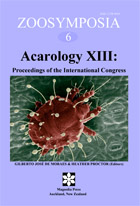Abstract
Generalist predatory mites belonging to the Phytoseiidae play a major role in keeping phytophagous mites below economic threshold levels in European apple orchards and vineyards. Apart from their primary prey, these phytoseiids can exploit a range of other foods, among which pollen and plant pathogenic fungi are very important. The ability of generalist predatory mites to feed on alternative foods is of importance for their persistence in perennial crops. Pesticides can exert dramatic effects on mite communities, and these effects can be more severe on predators than on phytophagous mites, with practical consequences for pest management. Several factors of intrinsic (e.g. resistance to stress) and extrinsic nature (e.g. immigration) can influence the response of predatory mite populations to pesticide applications. Environmental conditions, in particular availability of alternative foods, could affect the resilience of predatory mite populations after pesticide applications. Here we evaluate the role of availability of alternative foods on the response of predatory mite populations to pesticide applications in two crop systems: apple and grape. In the former, increasing the abundance of pollen through appropriate grass management resulted in less pronounced negative effects of some insecticides on the predatory mite Kampimodromus aberrans (Oudemans). In a controlled laboratory experiment, we demonstrated that availability of fresh pollen reduced the effect of pesticides on the fecundity of that predator. In the grape system, we found a positive effect of the plant pathogen grape downy mildew (GDM) on Amblyseius andersoni (Chant) populations, while some pesticides had a negative impact. GDM availability on plants favored the colonization by beneficial mites of pesticide treated plants with positive implications for mite persistence in vineyards.

